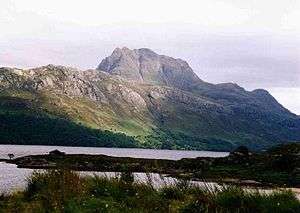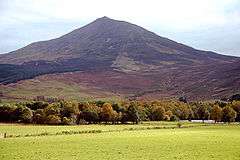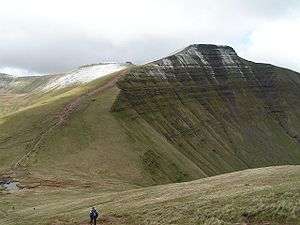Ben Macdui
Ben Macdui (Scottish Gaelic: Beinn Mac Duibh, meaning Mac Duff's Hill) is the second highest mountain in Scotland (and all of the British Isles) after Ben Nevis, and the highest in the Cairngorms National Park. The summit elevation is 1,309 meters (4,295 feet) AMSL. Ben Macdui lies on the southern edge of the Cairn Gorm plateau, on the boundary between the historic counties of Aberdeenshire and Banffshire (currently on the border between the Aberdeenshire and Moray council areas).
| Ben Macdui | |
|---|---|
| Beinn Mac Duibh | |
 | |
| Highest point | |
| Elevation | 1,309 m (4,295 ft) [1] |
| Prominence | 950 m (3,120 ft) Ranked 9th in British Isles |
| Parent peak | Ben Nevis |
| Isolation | 86.54 km (53.77 miles) [2] |
| Listing | Marilyn, Munro, Hardy, Council top (Aberdeenshire, Moray), County top (Aberdeenshire, Banffshire) |
| Naming | |
| English translation | Mountain of the son of Duff/MacDuff or possibly The Hill of the Black Pig (a reference to its shape) |
| Language of name | Gaelic |
| Pronunciation | Scottish Gaelic: [peɲ maʰkˈt̪ɯj] |
| Geography | |
| Location | Moray / Aberdeenshire, Scotland |
| Parent range | Cairngorms |
| OS grid | NN989989 |
| Topo map | OS Landranger 36, 43, Explorer OL57 |
| Climbing | |
| Normal route | Saddle at Loch Ericht (359 metres or 1,178 feet) |
After the defeat of Domnall mac Uilliam in 1187, Donnchad II, Earl of Fife, acquired Strathavon, a territory stretching from Ballindalloch to Ben Macdui. Because the mountain marked the western boundary of Donnchad's territory, Gaelic scholar historian F.C. Diack and place-name scholar Professor G.W.S. Barrow have suggested that the mountain took its name from Donnchad's family, the Mac Duibh,[3][4] however the name may derive from the Gaelic for a black pig,[5] muc dhubh.
Probably the easiest route of ascent is from the Coire Cas car park at the foot of Cairngorm Ski Centre by a path that leads up over slowly rising moorland. This route is about 7 km (4 mi) long; a somewhat longer route allows one also to climb Cairn Gorm. One possible alternative route follows the path coming up from Loch Etchachan. This loch may be reached from Loch Avon to the north or by coming up from Glen Derry to the south. Other routes include coming over Derry Cairngorm, or via the Lairig Ghru pass, which lies to the west of Ben Macdui.[6][7]
Nearly all these routes are long days by Scottish standards. When coming from the south it is common to use a bicycle to cover the 5 km (3½ mi) from the road end at Linn of Dee to Derry Lodge at the southern end of the massif.
Before the production of accurate maps of Scotland in the 19th century it was not known for certain that Ben Nevis was the highest point in Britain, and it was often thought that Ben Macdui might be the higher. Following surveys of both peaks in 1846-7, Ben Nevis was confirmed as the higher.[5] Following these surveys, there were plans to build a cairn on the top of Ben Macdui to make its height greater than Ben Nevis, but these plans did not come to fruition.[6] The summit of the mountain has a direction indicator erected in 1925 by the Cairngorm Club of Aberdeen in memory of a past president, Mr Alexander Copland. The indicator shows the directions of the most noteworthy mountains that can be seen from the summit in clear weather.
Snow patches have been known to persist at various locations on Ben Macdui, most notably Garbh Uisge Beag.
Queen Victoria hiked to the summit on 7 October 1859, aged forty. About her experience, she wrote: "It had a sublime and solemn effect, so wild, so solitary – no one but ourselves and our little party there ... I had a little whisky and water, as the people declared pure water would be too chilling."
The area of Ben Macdui is said to be haunted by the legendary Am Fear Liath Mòr, or Greyman.
Gallery
|
References
Citations
- "Ben Macdui (Beinn Macduibh)". Hill Bagging - the online version of the Database of British and Irish Hills (DoBIH). 2019. Retrieved 19 June 2019.
- "Ben Macdui isolation".
- Cairngorm Club Journal 1911.
- Barrow 1980, p. 86.
- Mitchell, p. 31.
- McNeish, p.p. 129-130.
- Bennett, Donald, et al., p. 132.
Bibliography
- Barrow, G. W. S. (1980), The Anglo-Norman Era in Scottish History: The Ford Lectures Delivered in the University of Oxford in Hilary Term 1977, Oxford: Clarendon Press, ISBN 0-19-822473-7
- Bennett, Donald, et al., The Munros, SMC Hillwalkers' Guide (Scottish Mountaineering Trust, 1985). ISBN 0-907521-13-4
- Cairngorm Club Journal, Excursions and Notes - Ben Muich Dhu, vol. 37 (1911), p.60.
- McNeish, Cameron, (1998), The Munros: Scotland's Highest Mountains, 2nd ed., Lomond Books, ISBN 0-947782-50-8CS1 maint: extra punctuation (link)
- Mitchell, Ian (2004). Scotland's Mountains Before the Mountaineers. Luath Press. ISBN 0946487391.
| Wikimedia Commons has media related to Ben Macdui. |







